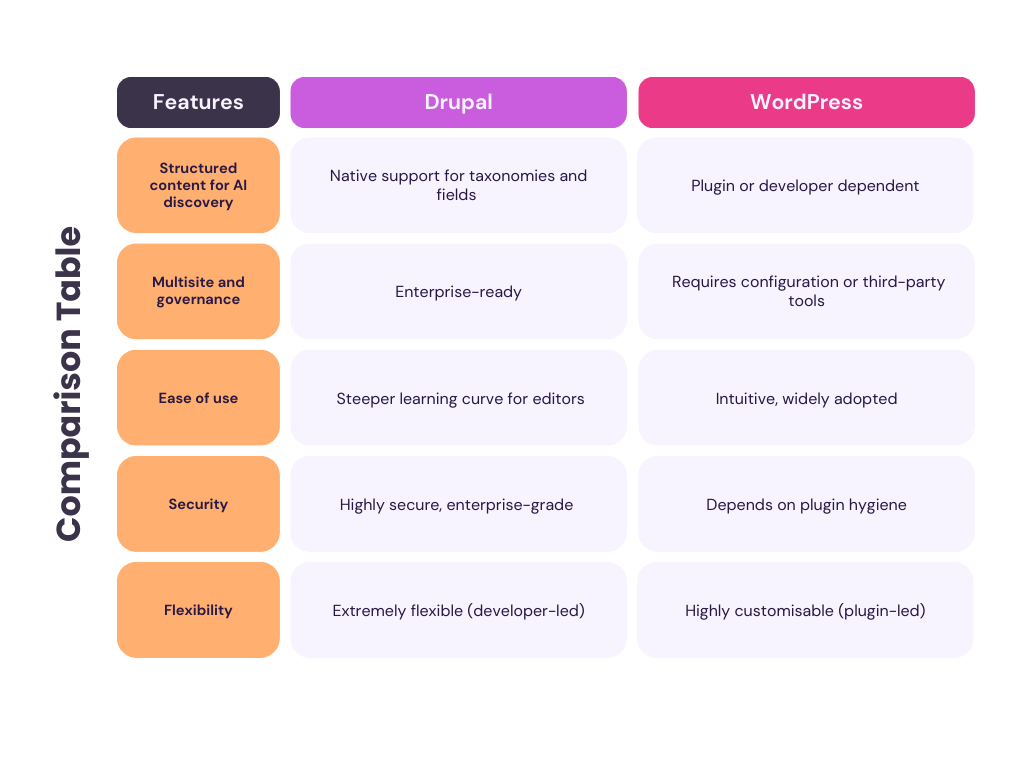The Best CMS Options for Universities in 2025
6bythree: CMS Buyer’s Guide for Universities and Research Organisations in 2025
Why Choosing the Right CMS Matters
Choosing the best CMS for higher education is not only a technical decision. It is, above all, a strategic one.
For universities and research organisations, their CMS supports everything from course listings and research data platforms to events, staff profiles, and student services.
An effective university website rebuild requires a solution that handles complex structures, multiple editors, integrations, and strict compliance. Accordingly, most institutions consider Drupal vs WordPress as their top contenders.

Key Requirements for Higher Education Platforms
As we’ve already explored Higher Education websites are unique in their requirements, here are the key requirements that your chosen CMS needs to meet.
Accessibility and Compliance
To begin with, every higher education site must meet WCAG 2.2 compliance standards and uphold strong data protection in HE. Both Drupal and WordPress can support these needs. However, Drupal offers built-in governance and accessibility frameworks. In contrast, WordPress often relies on plugins and manual configuration. As has been noted, governance and accessibility are not optional, they are foundational. In this instance, choosing the right CMS directly impacts your compliance strategy.
Scalability and Flexibility
Drupal is ideal for large-scale organisations with multilingual content, nested hierarchies, and multi-site estates. By comparison, WordPress is quicker to launch and more intuitive for smaller teams. Still, scaling WordPress often demands considerable customisation. In either case, the need for scalable CMS solutions is undeniable. Comparatively, Drupal’s structure supports that complexity more natively. Moreover, Drupal provides greater flexibility for managing complex academic structures.
Integrations with Internal Systems
In the education sector, seamless integration with CRMs (e.g. Dynamics, Salesforce), identity systems (e.g. Shibboleth, LDAP), and research data platforms is critical. Drupal offers an API-first approach, enabling robust CRM integrations. Conversely, WordPress often depends on third-party plugins, which can increase maintenance overheads. Not only does this impact scalability, but also affects the long-term sustainability of the platform.

Future-Proofing Your CMS Decision
Leading on to our next consideration. What needs to be consider when selecting your CMS to ensure it is future proofed?
Structured Content for AI Discovery
Given the shift toward AI-curated content and semantic search, your CMS must support structured content for AI discovery. Specifically, this includes:
- Semantic HTML
- Taxonomies and metadata
- Integration with knowledge graphs
Drupal, once again, leads in this area, out of the box. WordPress can match these needs using plugins like Yoast or ACF. What’s more, a well-structured content model ensures your site is visible across generative search tools.
Meeting Modern Expectations in Higher Education
Furthermore, your platform must enable content personalisation, mobile-first delivery, and decentralised publishing. These features are non-negotiable in any modern academic web strategy or university website rebuild.
Selecting the best CMS for higher education today means future-proofing for tomorrow. In addition, platforms must accommodate continuous improvement and evolving user needs.

Questions to Ask Before You Procure
In our experience, it is vital that any team procuring a new CMS or deciding whether to change CMS asks these following questions:
- Do we need a scalable CMS solution for multiple departments and languages?
- What is our capacity to manage plugins and custom updates?
- Are built-in accessibility and compliance priorities for our team?
- What are our CRM and open access digital platforms integration requirements?
- Does our team require a low-code or highly customisable framework?
By asking these questions upfront, institutions can avoid unnecessary costs and implementation delays.
Comparing Popular CMS Platforms
Whether you choose Drupal or WordPress, both are open source CMS for universities with strong global communities. Not only do they offer customisation, but they also provide cost-efficiency through license-free models. In the long run, both platforms can serve a wide range of digital goals, provided they are implemented strategically.
It’s the strategy not the platform that will ensure the desired impact.

How 6bythree Makes WordPress Work for Higher Education Clients

At 6bythree, we help clients implement WordPress in a way that is strategic, compliant, and scalable. That is to say, we go beyond templates and build tailored themes, integrate CRMs, and connect with open access digital platforms. Our approach ensures accessibility and long-term adaptability. With this purpose in mind, WordPress becomes a powerful option for teams needing speed and ease-of-use. As a matter of fact, it can offer surprising flexibility when configured correctly with the right digital partner.
How 6bythree Delivers Enterprise-Ready Drupal Solutions

Built for Complexity and Scale
For institutions requiring structured content, multi-site delivery, and deep integrations, Drupal is a strong foundation. To illustrate, we’ve built platforms with multilingual publishing, granular permissions, and API-first connectivity to CRMs and education sector digital tools. In essence, Drupal enables universities to design highly customisable, scalable systems that support their long-term goals.
Supporting Teams for Long-Term Success
In addition to implementing the technology, we empower internal teams through intuitive governance and editorial systems. As a result, our clients benefit from future-ready, sustainable solutions — with open access digital platforms that reflect a robust academic web strategy. Furthermore, our support ensures smooth onboarding and confident adoption.
Our Recommendation: Aligning Tech with Strategy
Each institution’s requirements vary, so your CMS decision should reflect your digital priorities, not just your team’s familiarity. With this in mind, below are our recommendations:
Choose Drupal
If your institution has complex needs, strict compliance expectations, and multiple stakeholders, these make Drupal a the clear fit. Its native support for multi-site governance, academic web strategy, and advanced integration makes it the best CMS for higher education in many use cases. Moreover, it’s especially well-suited to organisations needing precise editorial control and long-term scalability.
Choose WordPress
If your team needs a fast, editor-friendly platform with light integration needs, then WordPress may be ideal. With proper planning and governance, it too can serve as a reliable backbone for a modern university website rebuild. Additionally, its simplicity can be a significant advantage for decentralised teams.
To Conclude
In summary, whether you opt for Drupal or WordPress, your CMS choice should reflect your institutional goals. By aligning tech with long-term vision, embracing inclusion and compliance, and investing in scalable infrastructure, your organisation can thrive in 2025 and beyond.
Above all, selecting the best CMS for higher education is about strategy, not preference. With experience across both platforms and deep knowledge of website hosting for universities, data protection in HE, and education sector digital tools, 6bythree is here to help you build a future-proofed, strategically aligned and impact driven website.

